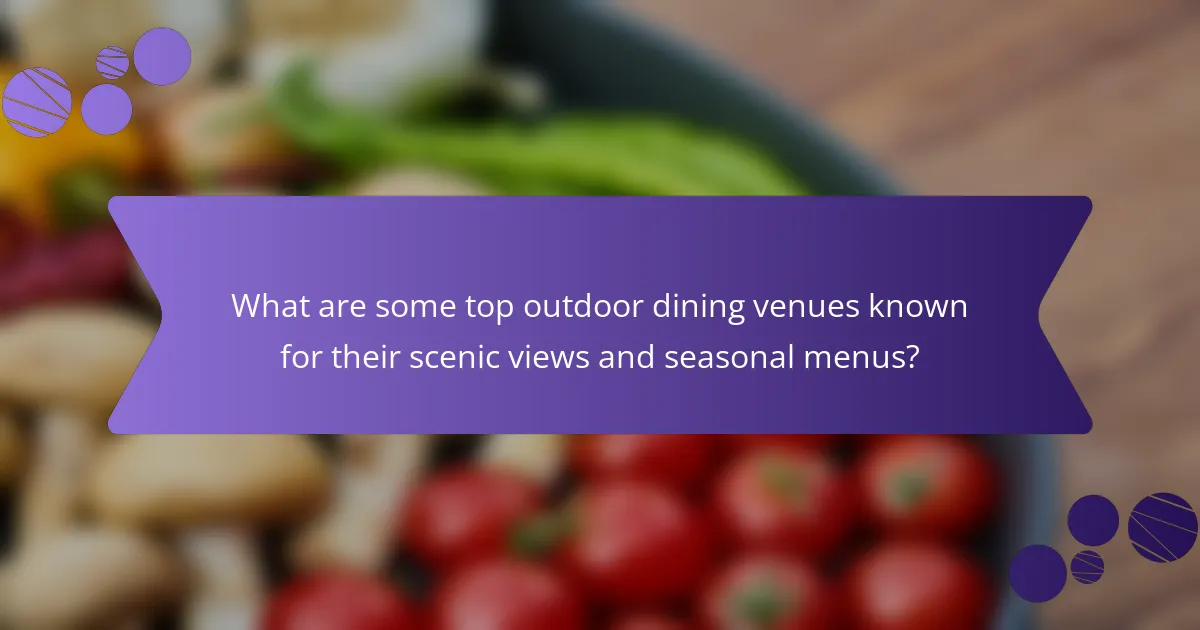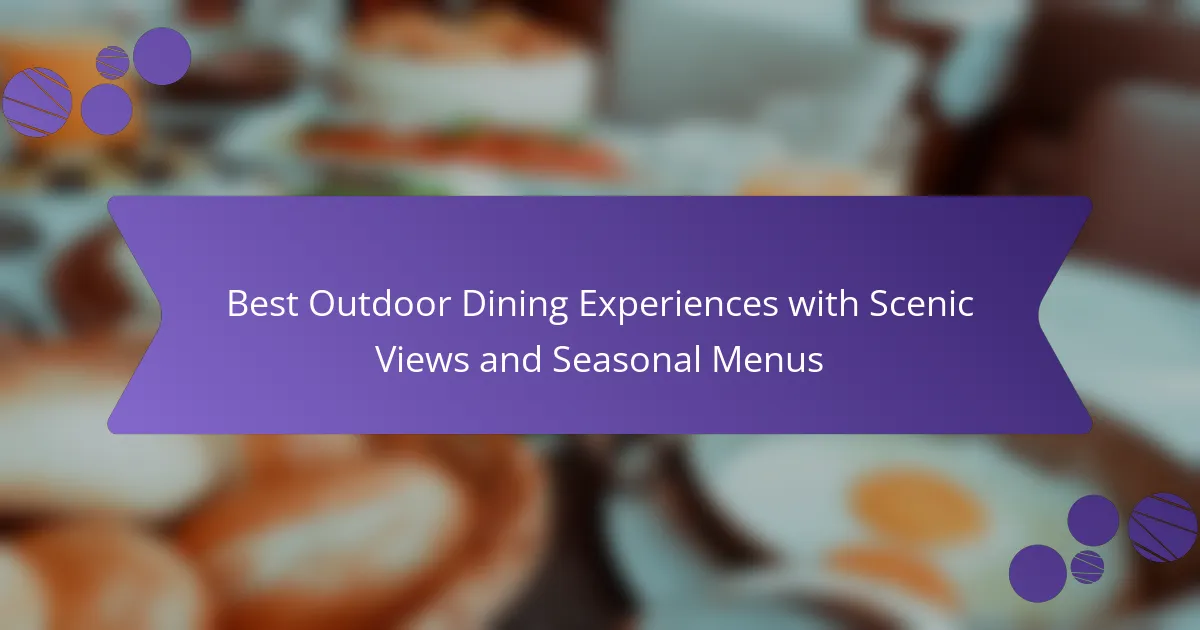
What are the Best Outdoor Dining Experiences with Scenic Views and Seasonal Menus?
The best outdoor dining experiences with scenic views and seasonal menus include locations that offer both aesthetic appeal and fresh, locally sourced cuisine. Restaurants like The River Café in New York City provide stunning views of the Manhattan skyline along with a seasonal menu focused on fresh ingredients. Similarly, the Cliff House in San Francisco features panoramic ocean views and a menu that changes with the seasons, highlighting local seafood and produce. Another example is The Rooftop at The Standard in Los Angeles, which offers breathtaking city views and a menu that reflects seasonal flavors. These establishments combine beautiful settings with culinary expertise, making them ideal for outdoor dining enthusiasts.
How do scenic views enhance outdoor dining experiences?
Scenic views enhance outdoor dining experiences by creating a visually appealing atmosphere. The natural beauty of landscapes can elevate the enjoyment of meals. Studies indicate that dining in picturesque settings can improve mood and satisfaction. For instance, a study published in the Journal of Environmental Psychology found that views of nature can reduce stress and increase relaxation. Additionally, scenic views often stimulate conversation and connection among diners. This social aspect can lead to a more memorable dining experience. Overall, the combination of aesthetics and ambiance contributes significantly to the pleasure of outdoor dining.
What types of scenic views are most popular for outdoor dining?
Mountain views are among the most popular scenic views for outdoor dining. They provide a breathtaking backdrop and a sense of tranquility. Waterfront views, such as lakes or oceans, are also highly sought after. These settings offer a soothing ambiance with the sound of water enhancing the dining experience. City skyline views attract diners looking for a vibrant atmosphere. The contrast of urban life against a sunset can be visually stunning. Garden views are favored for their natural beauty and peaceful surroundings. They create a serene environment filled with greenery and flowers. Each of these scenic views contributes to a memorable outdoor dining experience.
How do seasonal menus contribute to the overall dining experience?
Seasonal menus enhance the overall dining experience by offering fresh, locally sourced ingredients. These menus reflect the changing seasons, providing diners with unique flavors and dishes that align with the time of year. Seasonal offerings often increase the quality and taste of meals since ingredients are at their peak ripeness. According to a study by the Culinary Institute of America, seasonal menus can improve customer satisfaction by creating a sense of novelty and excitement. Additionally, they promote sustainability by reducing the carbon footprint associated with transporting out-of-season produce. This connection to the environment enriches the dining experience, fostering a deeper appreciation for the meal.
Why are seasonal menus important in outdoor dining?
Seasonal menus are important in outdoor dining because they enhance the dining experience by utilizing fresh, local ingredients. Fresh ingredients improve flavor and quality, making dishes more appealing. Seasonal menus also reflect the local culture and environment, creating a unique dining atmosphere. They can attract customers seeking variety and novelty throughout the year. Additionally, using local produce supports local farmers and reduces carbon footprint. Studies show that restaurants with seasonal menus often see increased customer satisfaction and loyalty. Overall, seasonal menus contribute to a memorable outdoor dining experience.
What benefits do seasonal menus provide to diners?
Seasonal menus provide diners with fresh, high-quality ingredients. These menus often highlight local produce, enhancing flavor and nutritional value. Seasonal offerings can create a unique dining experience that changes throughout the year. Diners enjoy discovering new dishes that reflect the current season. Additionally, seasonal menus often support local farmers and sustainable practices. This approach can lead to a lower environmental impact. Research shows that fresh ingredients can improve overall meal satisfaction. Diners are likely to appreciate the creativity and variety seasonal menus offer.
How do seasonal menus reflect local culture and ingredients?
Seasonal menus reflect local culture and ingredients by showcasing what is available at specific times of the year. These menus often highlight regional produce, meats, and seafood that are in season. For example, a summer menu may feature tomatoes, corn, and berries, while a winter menu might include root vegetables and hearty grains. This practice connects diners to the local agricultural cycle. It also fosters a sense of community by supporting local farmers and producers. Many chefs create dishes that are inspired by traditional recipes, enhancing cultural representation. The use of seasonal ingredients often leads to fresher, more flavorful meals. This approach can also reduce environmental impact by minimizing transportation of goods. Overall, seasonal menus serve as a culinary expression of local heritage and sustainability.

What factors should be considered when choosing an outdoor dining experience?
Location is a crucial factor when choosing an outdoor dining experience. Proximity to scenic views enhances the overall atmosphere. Weather conditions also play a significant role; pleasant weather makes outdoor dining more enjoyable. The menu offerings should align with seasonal ingredients for freshness and flavor. Ambiance influences the dining experience; consider the setting and decor. Service quality is essential; attentive staff can elevate the meal. Accessibility matters, especially for those with mobility issues. Lastly, reviews and recommendations provide insights into the dining experience from others.
How does location influence outdoor dining choices?
Location significantly influences outdoor dining choices by affecting ambiance, accessibility, and menu offerings. Urban areas often provide vibrant atmospheres with diverse culinary options. Scenic locations, such as waterfronts or parks, enhance the dining experience through natural beauty. Seasonal factors, like weather and local harvests, also dictate menu availability and outdoor seating preferences. Regions with mild climates typically see more outdoor dining year-round. In contrast, colder areas may limit outdoor dining to warmer months. Research indicates that restaurants in picturesque locations can attract more customers, as 70% of diners prioritize views when choosing eateries.
What are the best locations for outdoor dining with scenic views?
The best locations for outdoor dining with scenic views include coastal restaurants, mountaintop eateries, and lakeside cafes. Coastal restaurants often provide stunning ocean vistas, enhancing the dining experience. For example, establishments along the California coastline offer breathtaking sunset views. Mountaintop eateries can be found in regions like the Rockies, where diners enjoy panoramic mountain scenery. Lakeside cafes, such as those near Lake Tahoe, allow guests to dine surrounded by tranquil water views. These locations not only offer great food but also memorable atmospheres.
How does the ambiance of an outdoor dining space affect the experience?
The ambiance of an outdoor dining space significantly enhances the overall experience. A well-designed ambiance creates a welcoming atmosphere that encourages relaxation. Elements such as lighting, decor, and natural surroundings contribute to this effect. Studies show that pleasant environments can improve mood and satisfaction during meals. For instance, a research study published in the Journal of Environmental Psychology found that diners in aesthetically pleasing settings reported higher enjoyment levels. Additionally, outdoor spaces often integrate nature, which can have calming effects. The presence of greenery and fresh air can elevate the dining experience by making it more enjoyable and memorable. Thus, the ambiance directly influences diners’ perceptions and enjoyment of their meals.
What role does menu variety play in outdoor dining experiences?
Menu variety enhances outdoor dining experiences by catering to diverse tastes and preferences. A broad menu allows diners to choose from various cuisines and dietary options. This variety can attract a wider customer base. Research shows that restaurants with diverse menus often see increased customer satisfaction. For example, a study by the National Restaurant Association indicates that 67% of diners prefer menus with multiple options. Additionally, seasonal menus can highlight fresh, local ingredients, enhancing the overall dining experience. This connection to local produce can also improve the perceived quality of the meal. Overall, menu variety plays a crucial role in creating enjoyable and memorable outdoor dining experiences.
How can restaurants balance seasonal offerings with customer preferences?
Restaurants can balance seasonal offerings with customer preferences by conducting regular surveys to understand customer desires. They can analyze sales data to identify popular seasonal dishes. Offering limited-time seasonal specials can create excitement while catering to customer tastes. Collaborating with local farmers ensures fresh, seasonal ingredients that appeal to health-conscious diners. Additionally, restaurants can maintain core menu items that customers love while rotating seasonal options. This approach allows flexibility and responsiveness to customer feedback. Research shows that restaurants with seasonal menus can increase customer satisfaction by 20% when aligning offerings with preferences.
What types of cuisine are best suited for outdoor dining settings?
Casual and shareable cuisines are best suited for outdoor dining settings. Examples include barbecue, tapas, and picnic-style meals. These types of cuisine encourage social interaction. Barbecue offers grilled meats and sides that are easy to serve and enjoy outdoors. Tapas consists of small plates, allowing diners to sample various dishes. Picnic-style meals often include sandwiches, salads, and finger foods that are convenient for outdoor settings. Additionally, these cuisines often pair well with outdoor beverages like beer and wine. Their informal nature enhances the outdoor dining experience.

What are some top outdoor dining venues known for their scenic views and seasonal menus?
The top outdoor dining venues known for their scenic views and seasonal menus include The River Café in New York City, which offers stunning views of the Manhattan skyline. Another notable venue is The Cliff House in San Francisco, renowned for its ocean views and fresh, locally sourced ingredients. In Chicago, The Signature Room at the 95th provides breathtaking views of the city along with a seasonal menu. Additionally, The Grove in Los Angeles features a picturesque setting with seasonal dishes inspired by local produce. Each venue combines scenic beauty with a commitment to seasonal dining, enhancing the overall experience for guests.
Which restaurants are renowned for outdoor dining experiences?
The restaurants renowned for outdoor dining experiences include The River Café in New York, known for its stunning views of the Manhattan skyline. Another notable mention is The Cliff House in San Francisco, which offers breathtaking ocean views. In Chicago, The Aviary features a rooftop terrace with a unique dining atmosphere. Additionally, Le Bernardin in New York provides an outdoor terrace for a fine dining experience. These establishments consistently receive high ratings for their ambiance and scenic locations. They are often highlighted in travel and food publications for their exceptional outdoor settings.
What makes these restaurants stand out in terms of views and menus?
These restaurants stand out due to their breathtaking views and innovative seasonal menus. The stunning vistas often include waterfronts, mountains, or city skylines. Such locations enhance the dining experience, making it memorable. Seasonal menus utilize fresh, local ingredients, ensuring high quality and flavor. This approach also reflects the changing seasons, offering diners variety throughout the year. Many establishments change their offerings monthly or quarterly, keeping the menu exciting. The combination of picturesque settings and creative dishes attracts food enthusiasts and nature lovers alike. This unique blend creates a distinctive dining atmosphere that is hard to replicate.
How do customer reviews reflect the quality of these outdoor dining venues?
Customer reviews are a critical indicator of the quality of outdoor dining venues. They provide firsthand accounts of customer experiences. Positive reviews often highlight aspects such as food quality, service, and ambiance. For example, a review mentioning “fresh seasonal ingredients” reflects the venue’s commitment to quality. Negative reviews can reveal issues like poor service or unclean environments. Consistent feedback across multiple reviews can establish a venue’s reputation. Studies show that 84% of people trust online reviews as much as personal recommendations. Therefore, customer reviews serve as a reliable measure of an outdoor dining venue’s overall quality.
What tips can enhance your outdoor dining experience?
To enhance your outdoor dining experience, choose a comfortable seating arrangement. Comfortable seating promotes relaxation and enjoyment during meals. Consider the weather conditions when planning your dining. For instance, shade is essential on sunny days, while a windbreak may be needed in breezy conditions.
Incorporate ambient lighting for evening meals. Soft lighting creates a warm atmosphere that enhances the dining experience. Use tablecloths or placemats to add a touch of elegance. This simple addition can elevate the overall aesthetic of your outdoor setup.
Select seasonal menus that reflect local produce. Fresh ingredients improve flavor and support local farmers. Pair your meals with appropriate beverages. A well-chosen drink can complement the flavors of your food.
Finally, consider background music to set the mood. Music can enhance the ambiance and create a more enjoyable atmosphere.
How can you choose the best time to dine outdoors for optimal views?
To choose the best time to dine outdoors for optimal views, consider the time of day and weather conditions. Early morning offers soft light and fresh perspectives. Late afternoon to sunset provides vibrant colors and picturesque skies. Clear weather enhances visibility of the landscape. Seasonal changes also impact views; spring blooms or autumn foliage can enrich the experience. Research indicates that dining during golden hour maximizes visual appeal. This period occurs shortly after sunrise and before sunset, creating ideal lighting for scenery.
What should you consider when selecting dishes from seasonal menus?
Consider the freshness of ingredients when selecting dishes from seasonal menus. Seasonal menus typically feature ingredients that are at their peak flavor and nutritional value. Fresh produce is often more flavorful and vibrant. Another factor is the preparation style, which may highlight the seasonal ingredients effectively. Additionally, consider local sourcing, as dishes made with locally sourced ingredients support regional agriculture. Lastly, assess dietary preferences and restrictions to ensure a satisfying dining experience.
The main entity of this article is outdoor dining experiences that feature scenic views and seasonal menus. The article explores various locations known for their aesthetic appeal and fresh, locally sourced cuisine, highlighting establishments such as The River Café in New York City and The Cliff House in San Francisco. It discusses how scenic views enhance dining experiences, the significance of seasonal menus in providing fresh ingredients, and factors to consider when choosing outdoor dining venues. Additionally, it addresses the impact of ambiance, menu variety, and customer reviews on the overall dining experience.




